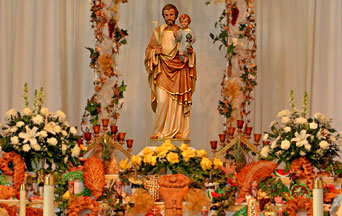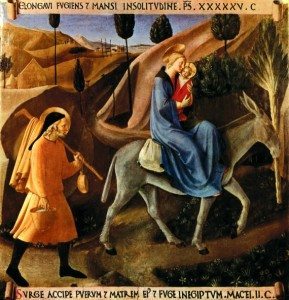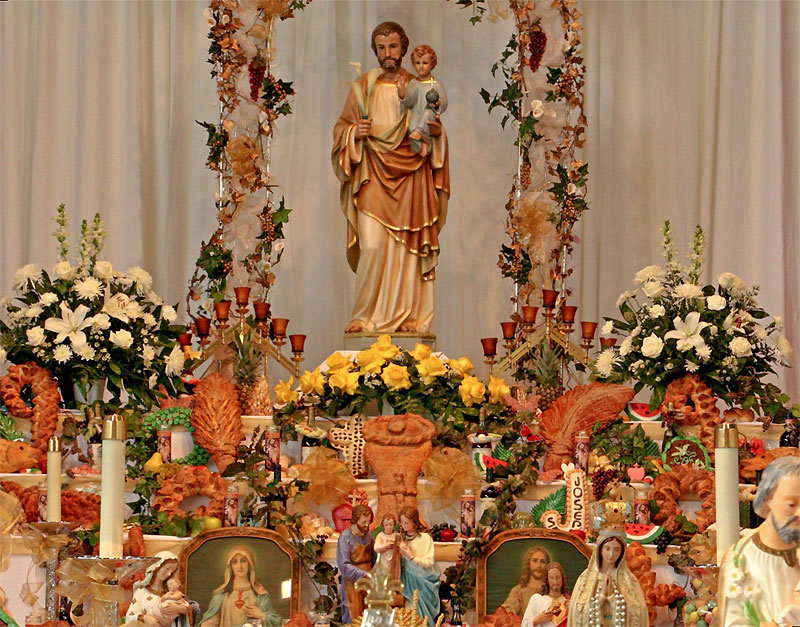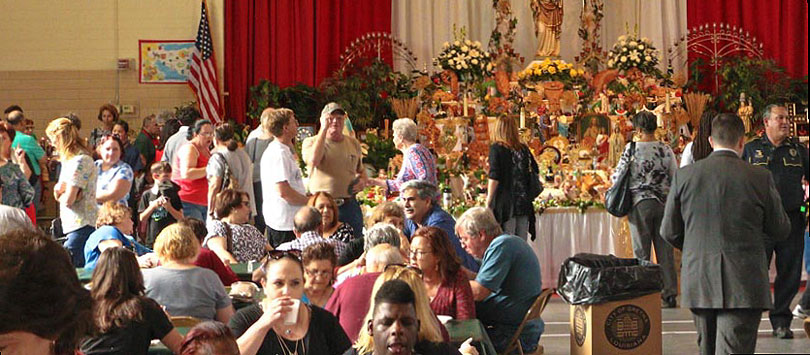
Every year New Orleans plays host to a longstanding Catholic tradition which has its origins in the Middle Ages. On Saint Joseph’s Day, March 19th, Catholics all over the city are eager to show their devotion to the head of the Holy Family. The celebration serves as a striking contrast in a place known more for the Mardi Gras spirit.
This author had the privilege of visiting many Saint Joseph’s Altars throughout New Orleans on Saint Joseph’s Day in 2018. Even better, I saw firsthand the devotion people from all walks of life have for this great saint. Serious Catholics can be seen on Saint Joseph’s Day traveling from one altar to the next to pray and give thanks. These altars are found in churches and private homes, Knights of Columbus halls and restaurants, grocery stores and Catholic schools. In a city known for hospitality, the Saint Joseph’s Altar tradition fits right in as people from all walks of life are welcomed to partake in the celebration honoring the Patron of the Universal Church.
A Tradition From the Middle Ages
Saint Joseph’s Altars began many centuries ago in Sicily. A prolonged drought led to loss of crops all over the island. Famine was imminent. The Sicilians were never tempted to despair. They collectively made a vow, promising Saint Joseph special honors should he deliver them from starvation.
The prayers of the Sicilians were quickly answered. Saint Joseph heard their pleas from Heaven and sent rain in abundance. A bountiful harvest resulted, sparing the people from misery. In thanksgiving, the people of Sicily began constructing altars with Saint Joseph having the place of prominence. Breads, cakes, pasta, fish, and all manner of foods would be displayed on the altar. The poor were to eat and have their fill first, and any leftovers would be donated.
Over the centuries many unique traditions developed. The descendants of these Sicilians brought the Saint Joseph’s Altar tradition to New Orleans in the nineteenth century. Since then it has been preserved not just in that city, but has spread across America.
A Feast Filled With Symbolism
Every altar has its unique character. There are certain traditions that those who host an altar always adhere to, beginning with the very practical tradition that those hosting an altar begin fundraising from the beginning of the year. No one can go into debt to have a Saint Joseph’s Altar in their home.
The altar is arranged on three levels, representing the Holy Trinity. In the center of the top level is Saint Joseph holding the Child Jesus. The altar is decorated with bread baked in various shapes. Hammers, ladders, and carpenter’s squares symbolizing the tools Saint Joseph used while on Earth are common sights. Bread in the shape of his staff and shoes can be seen. The eyes marvel at shapes such as fish, chalices, monstrances, and other Christian symbols all formed from the same dough. Bottles of wine, local seafood, vegetables and other foods are seen in all directions. An array of flowers, candles, pictures of other saints, and images of deceased loved ones also decorate the altar.
Finding Room for the Holy Family

The altars are displayed for some days prior to Saint Joseph’s Day. After the solemn blessing, a ceremony takes place called the tupa tupa (literally, “knock knock”). A boy and a girl representing Saint Joseph and Mary with a younger boy representing the Child Jesus walk first to one door and say the words “tupa tupa.”
From inside someone answers: “Who’s there?”
“Jesus, Mary and Joseph, we are seeking shelter.”
“Go away, there’s no room for you here.”
At the second door, the same is repeated.
Finally, at the third door, the door where the altar is, a third “tupa tupa” is said.
“Who’s there?” “Jesus, Mary and Joseph, we are seeking shelter.”
The reply comes back: “Come in! Come in! There is room for you here.” The three children then take the places reserved for them beside the altar. The altar is then dismantled as the food is served. The abundance of food is served throughout the day. Any leftovers or donations collected go to the poor.
Saint Joseph: Nourishing Body and Soul
As Saint Joseph’s Day always falls during Lent, a meatless spaghetti is traditionally served. Pasta covered with “red gravy” (as the sauce is known in Louisiana) is usually topped with mudrica, which are spiced breadcrumbs symbolizing sawdust from Saint Joseph’s workshop.
According to tradition, during the Sicilian drought in the Middle Ages, the only crop that still grew was the fava bean. Each person who visits an altar is encouraged to take one. Saint Joseph ensures that whoever takes a fava bean, though down to his last penny, will never be completely destitute in the year that follows.
Guests also receive a piece of bread from the altar, but not to eat. The bread is kept until a storm arises. When the bad weather comes, one must toss the piece of bread outside and pray. Saint Joseph will give his protection during the storm. The visitors to an altar always receive a bag of Italian cookies to take home. At one New Orleans parish, the ladies team up and bake more than 30,000 cookies for Saint Joseph’s Day. One of the organizers said, “You might not believe it, but we baked all of these cookies in a single day.”
Promises Kept
The personal stories of the families that host altars today never fail to impress. We share a few of them with our readers here.
Mr. Trinity Martinez has been hosting the Saint Joseph’s Altar in his home for the past few years. His Sicilian grandparents always hosted the altar in their home yearly, but many years ago he and his brothers and sisters let the family tradition fall by the wayside.
In 2008, Trinity’s wife Marsha was diagnosed with breast cancer. Given a dire prognosis by the doctors, the couple had recourse to prayer. Trinity promised Saint Joseph that should he bring Marsha through the ordeal, he would host an altar at his home every year. Since 2010, Marsha has been cancer free. The two of them quickly went about contacting everyone they grew up with to organize a Saint Joseph’s Altar at their home. Every year since, the Martinez family has shown their gratitude to the earthly father of Christ by hosting an altar and throwing an abundant feast.
As I spoke with him, Mr. Martinez showed me an old mortar and pestle. This was the tool brought by his grandparents from Sicily for grinding the figs for the Italian cookies. This same tool passed down through the generations is what they still use for making the cookies today. Mr. Martinez was also quick to point out that the number on his house is 319, the same as the date of Saint Joseph’s Feast Day.
Novena to Saint Joseph
A few miles away, Mrs. Jocelyn Clementine opens her abode each year when she hosts a Saint Joseph’s Altar. “We’ve been having the altar every year for the past twenty-seven years,” she tells me. “It was Saint Joseph who got us safely through Hurricane Katrina. Continuing to host the altar is the least I could do to show my gratitude.” Mrs. Clementine certainly does her best to get the word out, as a steady stream of visitors file through. Some stop to say a prayer, others pause in quiet admiration.
At Saint Joseph’s Church in Gretna, Louisiana, across the river from New Orleans, the parish hosts an altar honoring Saint Joseph that is incredible to behold. Hundreds of people spend months preparing a bounteous display that takes up the majority of one side of a large gym. Over the course of the day, countless people file through at all hours. Friends old and new converse, photographs of the marvelous altar are taken, and many prayers beseeching Saint Joseph’s blessings are poured out.
 And then there is the food. The best cooks are recruited for the day-long feast. Some have to rush off to work. Others remain and help in any way they can. One of the many volunteers told me, “I’ve been doing this for years, and I look forward to it every year. This is a labor of love. Anything for Saint Joseph!”
And then there is the food. The best cooks are recruited for the day-long feast. Some have to rush off to work. Others remain and help in any way they can. One of the many volunteers told me, “I’ve been doing this for years, and I look forward to it every year. This is a labor of love. Anything for Saint Joseph!”
The Glory of Home Life
During World War II, many families in New Orleans saw their sons go off to fight. Even though there were shortages and rationing, the Saint Joseph’s Altars were still erected each year. Families begged Saint Joseph to return their loved ones safely. After the war’s end, many more altars were erected in gratitude. Today’s altars in so many homes show that the Holy Family is still the ideal to aspire to, and Saint Joseph is the one to confide in for domestic peace. It is with good reason the Church calls him “the glory of home life.”
In the book The Life and Glories of Saint Joseph, Edward Healey Thompson comments on the Holy Family’s home at Nazareth: “What inconceivable perfection and holiness of life was there displayed! The angels looking on in adoring admiration might have reversed the words of our prayer, and have besought God that His will might be done in Heaven, as it was done on earth by Jesus, Mary and Joseph.”
Science Confirms: Angels Took the House of Our Lady of Nazareth to Loreto
Quotes from the saints who had devotion to Saint Joseph were easy to spot on many an altar. Of those which could be mentioned, Saint Teresa of Avila’s famous lines really stood out:
“Would that I could persuade all men to be devoted to this glorious Saint [Joseph], for I know by long experience what blessings he can obtain for us from God. I have never known anyone who was truly devoted to him and honored him by particular services who did not advance greatly in virtue: for he helps in a special way those souls who commend themselves to him. It is now very many years since I began asking him for something on his feast, and I have always received it. If the petition was in any way amiss, he rectified it for my greater good … I ask for the love of God that he who does not believe me will make the trial for himself—then he will find out by experience the great good that results from commending oneself to this glorious Patriarch and in being devoted to him.”
Saint Thomas Aquinas also encouraged recourse to the Pillar of Families:
“Some Saints are privileged to extend to us their patronage with particular efficacy in certain needs, but not in others; but our holy patron St. Joseph has the power to assist us in all cases, in every necessity, in every undertaking.”
Saint Joseph: Giving Rest to Tired Souls
It is clear on visiting several altars that Saint Joseph is especially fatherly to world-weary souls. Kneeling down, burdened with illness, financial woes, family problems and all manner of worries, they rise comforted and consoled. Prayer cards of every description with prayers to Saint Joseph are at every altar. Many faithful pause to write their petitions.
One surprising sight at many an altar was a statue of Saint Joseph sleeping. In the Gospels, Saint Joseph had many things revealed to him in his dreams. Mr. Joseph Talamo told of his own devotion to a sleeping Saint Joseph: “Any time I have a problem that I can’t find a solution for, I write it down on paper and place the paper under the statue. I always pray: ‘Saint Joseph, sleep on it.’ And he resolves it every time.”
The Patron of a Happy Death
The largest church in New Orleans is Saint Joseph Church. Built by immigrants at the end of the nineteenth century, the massive edifice hosts a large annual Saint Joseph’s Day celebration. The Saint Joseph’s altar is prominent inside the church with its vast amount of food and decorations. Above is a life-size statue of the patron of the parish. On the wall higher still is a large fresco depicting Saint Joseph on his deathbed. He is surrounded by Our Lady and Our Lord, Who gives him His blessing. The sublime scene is a reminder to every visitor to have recourse to the head of the Holy Family for a happy end to this earthly sojourn. Prayer cards given out feature this short prayer invoking Saint Joseph for a good death:
O Blessed Joseph, who yielded up thy last breath in the arms of Jesus and Mary, obtain for me this grace, O holy Joseph, that I may breathe forth my soul in praise, saying in spirit, if I am unable to do so in words: “Jesus, Mary and Joseph, I give Thee my heart and my soul.” Amen.
The Patron of the Universal Church
Pope Pius IX officially proclaimed Saint Joseph as Patron of the Universal Church in 1870. As the Church in the United States today is being rocked by scandal, let us have recourse to Saint Joseph. He preserved the Holy Family from every danger, and will do the same for those who have recourse to him today.
Professor Plinio Corrêa de Oliveira once wrote at length on this illustrious title:
“Imagine for a moment what it takes to be the patron saint of the Catholic Church! He must be someone so high, so exalted that he must be almost a reflection of the Church he guards! In order to be proportional to her, he must reflect of the Church he guards. We should consider that the spirit of Saint Joseph is identical to the spirit of the Catholic Church…The fact is that Saint Joseph, being the Spouse of Our Lady, was proportional to her. And to be the adoptive father of the Child Jesus, he must be proportional to the Child Jesus!
“We must imagine what people think of the Catholic Church, all of the grandeur of the Church, all of the simplicity of the Church, all of the dignity of the Church, all the affability of the Church, all of the wisdom of the Church, all of the immensity of the Church, all that can possibly be said of the Catholic Church and imagine it realized in one man! And then we would have the moral profile of Saint Joseph…
Saint Joseph, Martyr of Grandeur
“Let us imagine, at least, the moral profile of this saint: the chastity of Saint Joseph, his indescribable purity. And we should approach him with respect, with veneration and ask him to give us that which we most desire to receive…
“The first of the graces we should ask for would be the grace of devotion to Our Lady. Another grace we should ask of him is the grace to reflect so well the spirit of the Catholic Church however much it was in the designs of Providence to have created us and conferred on us at holy baptism.”
Saint Joseph, Patron of the Universal Church, protect and defend now the inheritance of Jesus Christ!
A Tradition Best Preserved in America
Though the Saint Joseph’s Altar tradition is of Sicilian origin, sadly in much of Sicily the altars are no longer made. The Sicilians who came to America through New Orleans, though, not only maintained the custom but spread it far and wide. In every part of the country today, Catholics gather to honor Saint Joseph with their own altars.
Months of hard work and preparation go into making these altars that will only be up for a few days. And yet, even in the twenty-first century, the tradition that calls for such sacrifice not only survives but thrives. Centuries after the tradition was introduced, so many Americans are willing to sacrifice to honor Saint Joseph in this labor of love. The Saint Joseph’s Altar tradition serves as a stark contrast to the modern spirit of instant gratification, giving hope for America.
Novena to Saint Joseph
Recite for nine days (March 11th-19th) for anything you may desire.
It has seldom been known to fail.
O Saint Joseph, whose protection is so great, so strong, so prompt before the throne of God, I place in thee all my interests and desires. O Saint Joseph, do assist me by thy powerful intercession, and obtain for me from thy divine Son all spiritual blessings, through Jesus Christ, our Lord, so that, having engaged here below your heavenly power, I may offer my thanksgiving and homage to the most loving of Fathers. O Saint Joseph, I never weary contemplating you and Jesus asleep in your arms; I dare not approach while He reposes near your heart. Press Him in my name and kiss His fine head for me and ask Him to return the kiss when I draw my dying breath.
Saint Joseph, patron of departing souls, pray for me.
